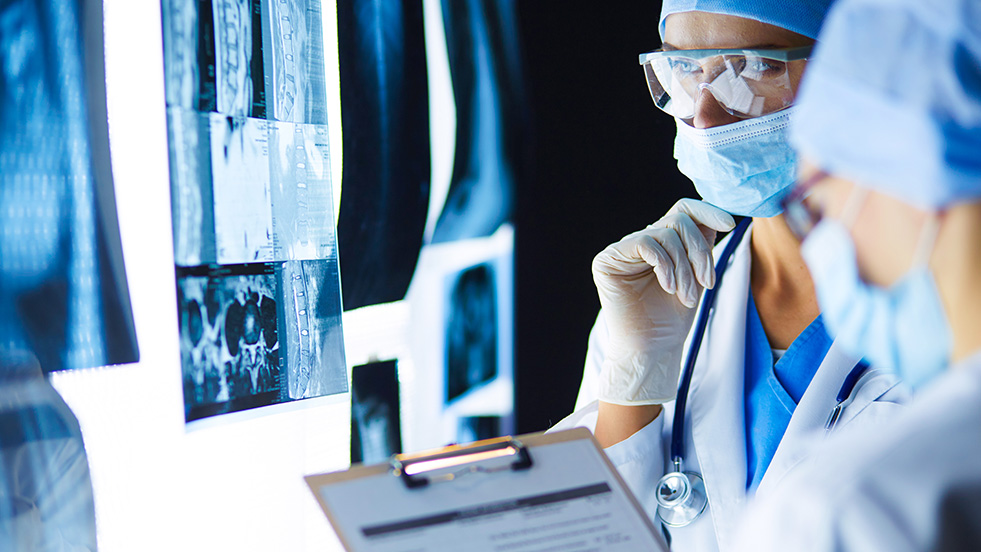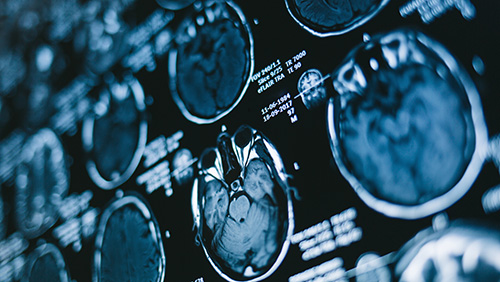
When we’re in the dark, it’s a natural instinct to turn on the lights and try to see. The hospital is no exception. Whether it’s to confirm a diagnosis or to achieve clarity about what condition might be causing a symptom, ordering imaging—MRIs, CT scans, and others—is a ubiquitous part of standard medical practice.
Many scans and images offer critical insight into diagnosis or treatment. Yet some are considered low-value: On the spectrum of appropriate-use criteria established by the American College of Radiology, these imaging studies, ordered day in and day out in hospitals across the country, are inappropriate.
There’s an unseen cost to these unnecessary medical scans, according to Michael Atalay, MD, PhD, P’27, director of Cardiac MRI and CT at Brown, and Gregory Cavanagh MD’24, who quantified the waste accrued by excess imaging in a recent study.
The results, published in the Journal of the American College of Radiology, were staggering. Using the 2014 RAND Corporation report, a government report on Medicare Imaging Demonstration, and data from the Harvey L. Neiman Health Policy Institute on trends in imaging for Medicare patients, the research team found that, during the four-year study period, inappropriate imaging may have generated up to about 129 kilotons of greenhouse gases annually—equivalent to a year’s worth of emissions from a 70,000-person town.
“Insurance companies are paying for all of these [unnecessary] studies. The radiologist is paying for it with a huge burden of unnecessary studies to read. Patients are exposed to ionizing radiation, potentially productivity loss [taking time away from work for imaging appointments], the inconvenience of follow-up, and unnecessary anxiety,” says Atalay, a professor of diagnostic imaging and of medicine. “But we’re all paying for it in terms of unnecessary carbon emissions.”
Atalay has long had an interest in identifying creative solutions to medical problems. After coming to Brown in 2003, with a background in physics and biomedical engineering, he helped establish the Cardiac MRI and CT service at Rhode Island Hospital and served for 10 years as vice chair of Imaging Research. “There’s an immense joy of discovery in science, and I’ve always found that to be appealing,” he says.
 It was Atalay’s longstanding interest in climate and the biosphere that sparked this project, says Cavanagh, a diagnostic radiology resident at Lahey Hospital & Medical Center in Burlington, MA. When chatting with Atalay during his third-year radiology rotation, Cavanagh saw the potential to give a “1,000-foot perspective of where radiology can come into contact with the environment.”
It was Atalay’s longstanding interest in climate and the biosphere that sparked this project, says Cavanagh, a diagnostic radiology resident at Lahey Hospital & Medical Center in Burlington, MA. When chatting with Atalay during his third-year radiology rotation, Cavanagh saw the potential to give a “1,000-foot perspective of where radiology can come into contact with the environment.”
Cavanagh grew up spending time outdoors as a Boy Scout. His focus on environmental conservation continued into college and beyond, leading him to serve on The Warren Alpert Medical School’s Environmental Coalition.
“If I wasn’t going to medical school, I think I would have considered a career in environmental engineering,” Cavanagh says with a laugh. With Atalay’s mentorship, he decided to connect his passion for health care with his other interests in environmental stewardship.
What he sought to convey through the paper is that small actions can have an enormous ripple effect. “The sheer number of imaging studies is so large across the country and the world that any marginal amount of waste amplified over the millions of studies can end up accounting for a tremendous amount of energy wasted,” Cavanagh says. While their study focused on electrical energy waste, he pointed out that material waste accrues too, in the form of excess contrast agents and packaging, equipment needed to process the imaging, and cleaning materials after studies are finished.
Imaging is essential for medicine as we know it. “I feel very lucky to be doing what I’m doing, because radiology does have a major impact on almost all other specialties,” Atalay says. That impact can be tapped into for environmental benefits. Atalay believes education can make a difference even before firm policies are put in place to reduce low-value imaging. “One potential strategy for reducing low-value imaging is to offer nudges during the ordering process that help guide care providers to make appropriate imaging choices,” he says. Grassroots efforts may indeed be the best way to see sizable positive impacts in medicine.
Cavanagh wanted their estimates to hit home with people. Using the US Environmental Protection Agency’s emissions calculator allowed the team to make estimates more accessible—like the size of a town with equivalent emissions or acreage of forest needed to sequester the carbon dioxide released by low-value imaging.
 Their research may help pave the way for more sustainable practices in radiology, and in the world of medicine at large. Striking a balance between excess and necessary diagnostic imaging parallels the need for balance in all of medicine.
Their research may help pave the way for more sustainable practices in radiology, and in the world of medicine at large. Striking a balance between excess and necessary diagnostic imaging parallels the need for balance in all of medicine.
“Care providers order studies because they have the patient’s best interests at heart,” Atalay says. “Physicians and other care providers often feel an onus to be near-perfect. Being wrong is not an option; this means that we find ourselves chasing zebras, with more and more testing, even though the hoofbeats we’re hearing are from horses.”
Cavanagh agrees: “Ultimately, we don’t want to sacrifice patient care. That’s why we sometimes need to do a systems-wide analysis in health care. Even though I want to save people today, I don’t want to hurt people tomorrow.”
Their work is a testament to the interdisciplinary nature of research at Brown. Inspired by Atalay, Cavanagh hopes to continue doing research in the area of planetary health through residency and beyond. “If there is something that gives you life,” Cavanagh says, “you’ll find a way to connect it to what you love.”